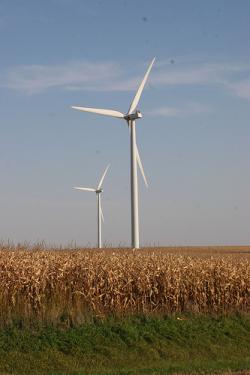
This post originally appeared on Energy Self-Reliant States, a resource of the Institute for Local Self-Reliance’s New Rules Project.
With the right renewable energy policy, hundreds of individuals can have a stake in a renewable energy future. That’s what happened with a cooperatively-owned wind project in South Dakota, where 7 turbines from a larger wind project are shared by over 600 local investors.
The largest barrier to community ownership of renewable energy has been the use of tax credits as the primary federal incentive for renewable energy. Tax credit incentives stymie cities, counties, and cooperatives from constructing and owning their own wind farm because they are tax exempt. But the temporary cash grant in lieu of the federal tax credit (expiring this December) has opened the door, and one South Dakota wind project has used the cash grant to become the largest cooperatively-owned wind project in the U.S.:
The Crow Lake Wind Project, built by electric cooperative Basin Electric subsidiary PrairieWinds SD 1, Inc., is located just east of Chamberlain, S.D. With 150 MW of the project’s 162 MW owned by Basin Electric subsidiary PrairieWinds SD1, Inc., the facility has taken over the title of being the largest wind project in the U.S. owned solely by a cooperative, according to Basin Electric. [emphasis added]
The project is also distinguished for having local investors in addition to ownership by the local cooperative:
The entire project consists of 108 GE 1.5-MW turbines, 100 of which are owned and operated by PrairieWinds. A group of local community investors called the South Dakota Wind Partners owns seven of the turbines, and one turbine has been sold to the Mitchell Technical Institute (MTI), to be used as part of the school’s wind turbine technology program, which launched in 2009. PrairieWinds, which constructed the seven turbines now owned by the South Dakota Wind Partners, will also operate them. [emphasis added]
The key to success was the limited-time opportunity for the cooperative to access the federal incentive for wind power:
The opportunity became viable following passage of 2009’s American Recovery and Reinvestment Act, which created a tax grant option allowing small investors to access government incentives and tax benefits, making public wind ownership possible. Creating the Wind Partners for that purpose were Basin Electric member East River Electric Power Cooperative, the South Dakota Farm Bureau Federation, the South Dakota Farmers Union and the South Dakota Corn Utilization Council…
“This development model created opportunity for small local investors to have direct local ownership in wind energy and access the tax benefits previously reserved for large equity investors,” said Jeff Nelson, general manager at East River Electric. “It offers a model for others to participate in community-based wind projects.”
The South Dakota Wind Partners consist of over 600 South Dakota investors, some who host the project’s 7 turbines and many who do not. Investors bought shares in increments of $15,000 (combinations of debt and equity). Brian Minish, who manages the project for the South Dakota Wind Partners, hopes to see future opportunities for this kind of development. “There’s a lot of political benefit in letting local people become investors in the project,” Minish said in an interview last month , “local ownership can help reduce opposition to wind power projects.”
Ownership also leads to significantly higher local economic benefits. It’s a big difference from a small change in federal policy.
Photo credit: Flickr user tinney


